- Регистрация
- 17 Февраль 2018
- Сообщения
- 26 053
- Лучшие ответы
- 0
- Баллы
- 2 093
Offline

Expert's Rating
Pros
- USB-C power with 98 watts of Power Delivery
- Great color performance
- Higher HDR peak brightness than some peers
- 240Hz refresh rate and outstanding motion clarity
- Stand is too large
- Works with FreeSync and G-Sync, but lacks certification
- SDR brightness is mediocre
The MSI MPG 341CQPX is yet another QD-OLED ultrawide, but it improves on its predecessors with better HDR, a 240Hz refresh rate, and USB-C port with 98 watts of Power Delivery.
Best Prices Today: MSI MPG 341CQPX
Retailer
Price
MSI
$849.99
View Deal
Price comparison from over 24,000 stores worldwide
Product
Price
Price comparison from Backmarket
The flood of ultrawide monitors with a Samsung QD-OLED display panel has turned into a tsunami. Every monitor maker has at least one, and many have several. However, the new MSI MPG 341CQPX floats atop this deluge with several features that few, if any, competitors offer. That includes a 240Hz refresh rate and a USB-C port with 98 watts of Power Delivery. The MPG 341CQPX isn’t perfect, but its advantages are notable.
MSI MPG 341CQPX specs and features
At a glance, the MSI MPG 341CQPX’s specifications look a lot like competitive QD-OLED monitors. It’s a 34-inch panel with a resolution of 3440×1440, it supports Adaptive Sync, and it has a wide variety of ports including USB-C.
- Display size: 34-inch ultrawide 21:9 aspect ratio
- Native resolution: 3440×1440
- Panel type: QD-OLED
- Refresh rate: Up to 240Hz
- Adaptive Sync: Adaptive Sync
- HDR: VESA DisplayHDR 400 certified
- Ports: 2x HDMI 2.1, 1x DisplayPort 1.4, 1x USB-C with DisplayPort Alternate Mode and 98 watts of Power Delivery, 1x USB-B upstream, 2x USB-A downstream, 1x 3.5mm audio out
- VESA mount: 100x100mm
- Speakers: No
- Price: $899.99 MSRP, $849.99 typical retail
However, the MSI has some advantages. It has a refresh rate of 240Hz, which is at the upper end of what’s available from OLED monitors right now, and uncommon in QD-OLED monitors. It also has a USB-C port with 98 watts of power delivery, which is more than many competitors. Despite this, it’s reasonably priced with an MSRP of about $900.
Shoppers be warned: MSI’s branding is a little confusing. It has an older monitor, the MSI MAG 341CQP, which looks similar, and currently comes up in search results for the MSI MPG 341CQPX. Be careful to double-check the listing and the model number of the monitor.
MSI MPG 341CQPX design
The MSI MPG 341CQPX’s design is its weakest trait, though that’s not to say it’s bad. The panel itself is a competent effort. From the front, the monitor has slim bezels on three sides and a small chin on the bottom. Turn it around and you’ll find an expanse of black plastic that feels sturdy. It’s broadly similar to the Gigabyte MO34WQC, but I think the MSI MPG 341CQPX looks a tad more expensive.
With that said, the MPG 341CQPX lags alternatives like the Alienware AW3423DWF, LG Ultragear 34GS95QE, or Samsung Odyssey G85SB. Those competitors have a more premium and professional look that’s a better fit for most desks.
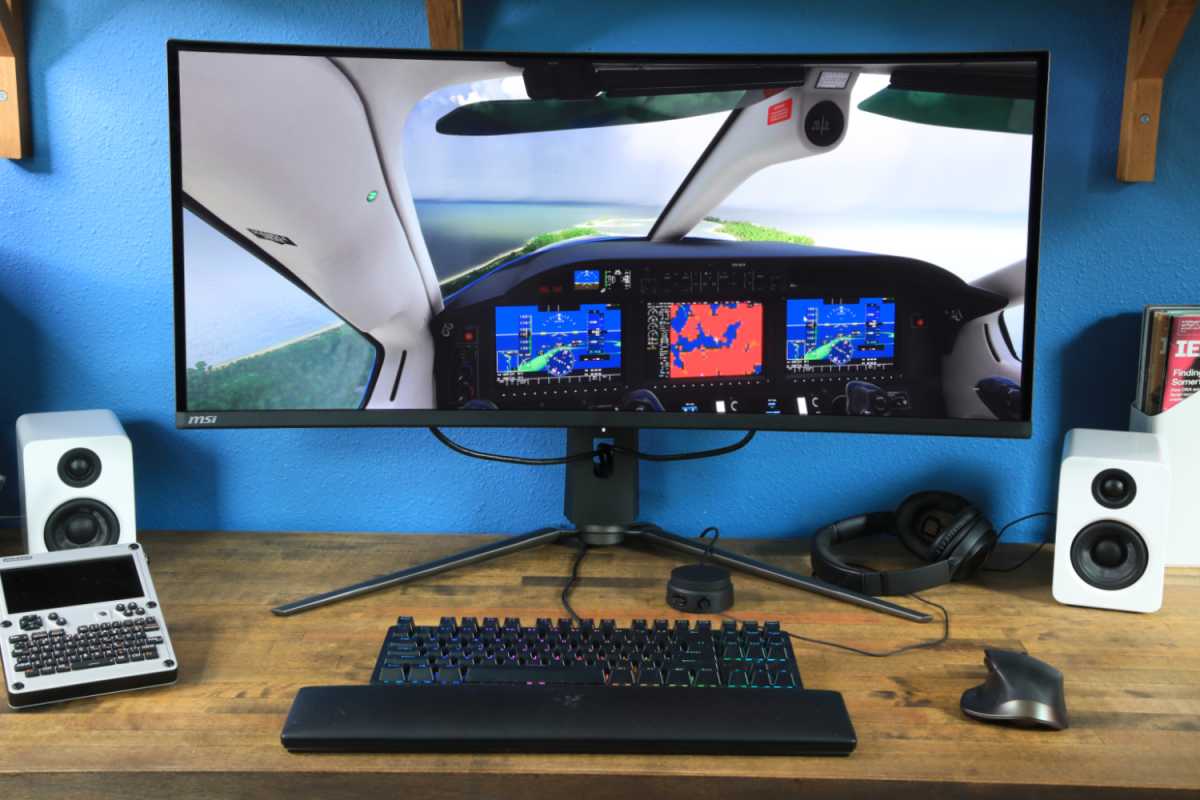
Matthew Smith / Foundry
Matthew Smith / Foundry
Matthew Smith / Foundry
The MPG 341CQPX also lacks RGB lighting. Personally, I don’t mind this, but most competitors that brand themselves as a “gaming monitor” offer some form of RGB lighting. Shoppers looking to add some flair to their desk might miss it.
MSI also makes the mistake of opting for a gigantic stand. It’s nearly as wide as the monitor itself, and a bit deep, which makes the monitor hard to fit on a small or shallow desk. While the broad stand gives the MPG 341CQPX a racy look, it also means you can’t use some of the space it occupies like, well, a desk. Also, to nitpick: I don’t think the stand base looks like it goes with the monitor. It’s more spindly, and a different color, which seems odd. A 100x100mm VESA mount is available, though, so the stand’s problems can be solved with a third-party monitor stand or arm.
MSI MPG 341CQPX connectivity and menus
The MSI MPG 341CQPX has an excellent range of connectivity for a 34-inch ultrawide gaming monitor.
Video connectivity includes two HDMI 2.1 ports, one DisplayPort 1.4, and one USB-C with DisplayPort Alternate Mode. MSI officially states that all of these ports support the monitor’s full resolution and refresh rate. The same is true of most 34-inch ultrawides, because 3440×1440 resolution isn’t especially high for a monitor in 2024. Still, it’s good to see.
The USB-C port also handles up to 98 watts of USB Power Delivery. That’s important, because it provides enough power to fully supply most Windows laptops designed to be charged over USB-C. Competitors like the Gigabyte MO34WQC have less power delivery. Others, like the Alienware AW3423DWF and LG Ultragear 34GS95QE-B, don’t have USB-C at all.
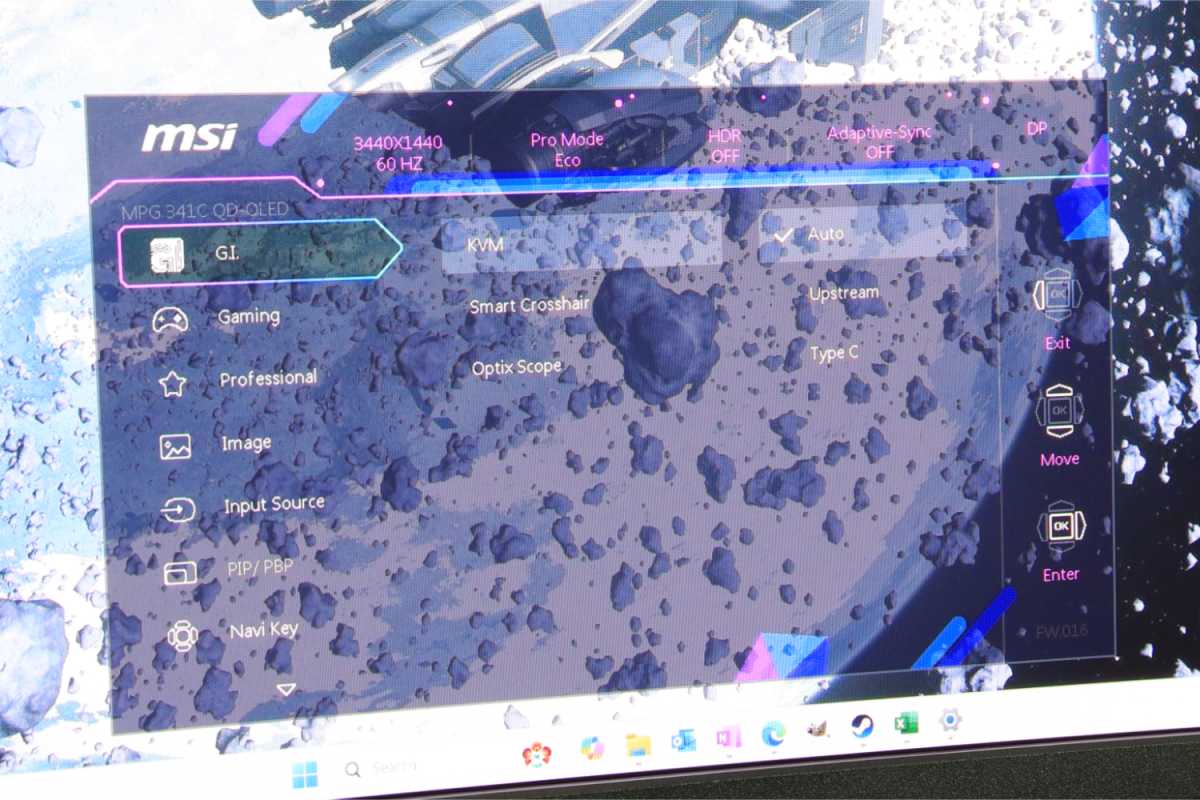
Matthew Smith / Foundry
Matthew Smith / Foundry
Matthew Smith / Foundry
MSI’s menu system is accessed with a responsive joystick control centered on the bottom panel. It’s easy to use, and MSI’s menus are logically arranged, well-labeled, and include many image quality customization options. This includes the usual gaming-centric features, like a black equalizer and on-screen crosshair, as well as utility features like picture-in-picture/picture-by-picture modes. MSI also has a Windows application which can be downloaded from the company’s website and used to control the monitor’s features. These features are typical for a monitor in the MPG 341CQPX’s price range, but they worked well in my experience.
Speakers are absent, however, so you’ll need to connect external speakers or headphones. This, too, is typical for a monitor in this category, but not universally true, as competitors like the Gigabyte MO34WQC include speakers.
The MPG 341CQPX can deliver an exceptionally deep and immersive image that’s far superior to an LCD monitor…
The MSI MPG 341CQPX is the first monitor I’ve reviewed with a QD-OLED panel that can achieve a refresh rate of 240Hz. Others, like the new Acer Predator X34, will arrive soon. OLED monitor communities are referring to this as a “gen 2.5” panel (the official specifications make no such claim). The new MSI does have some advantages in HDR performance and motion clarity. When it comes to SDR performance, however, not much has changed.
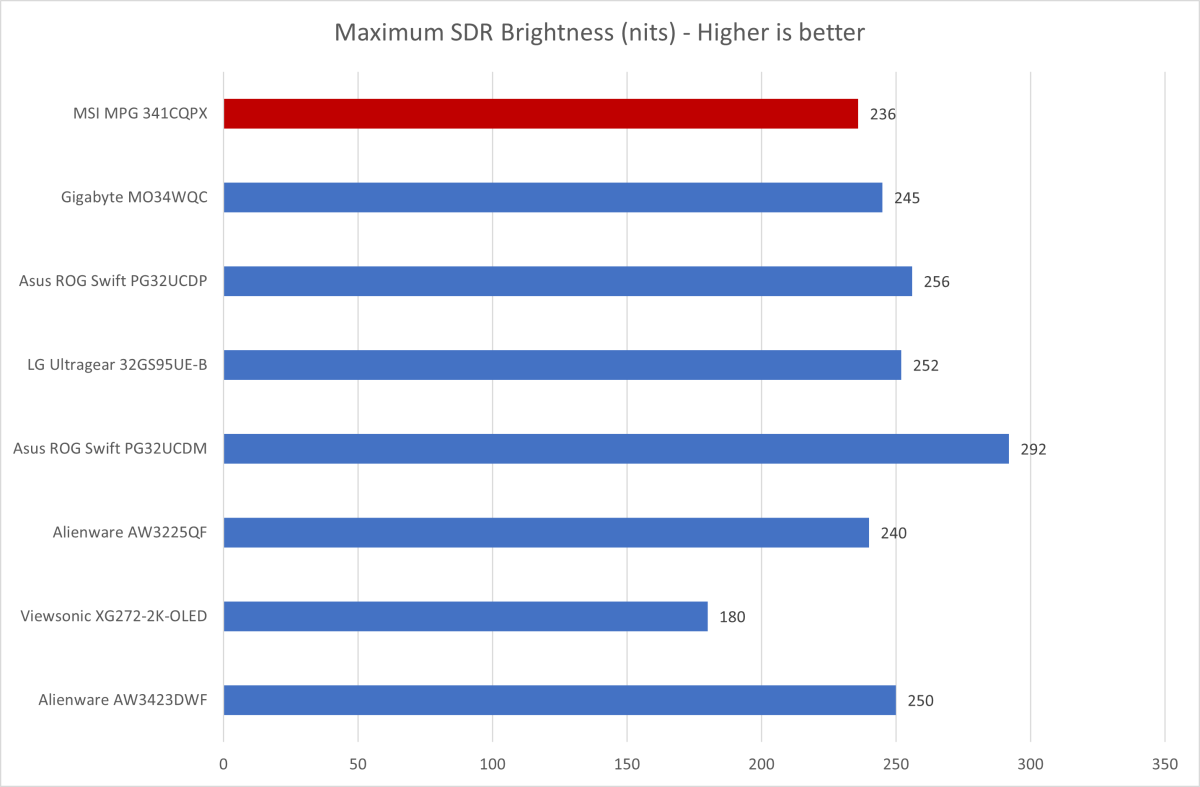
Matthew Smith / Foundry
Matthew Smith / Foundry
Matthew Smith / Foundry
First up is brightness, and there’s no surprises here. The MSI MPG 341CQPX’s sustained SDR brightness is arguably a little low compared to other OLED monitors, but not by a meaningful amount.
In general, the MPG 341CQPX’s brightness is fine for a room with light control, and in fact I often used it at a brightness level far below its maximum. However, it could appear a bit dim in an extremely bright room, such as one with floor-to-ceiling sunlit windows. In that case, you might want to look at a monitor that relies on different panel technology, such as a Mini-LED monitor.
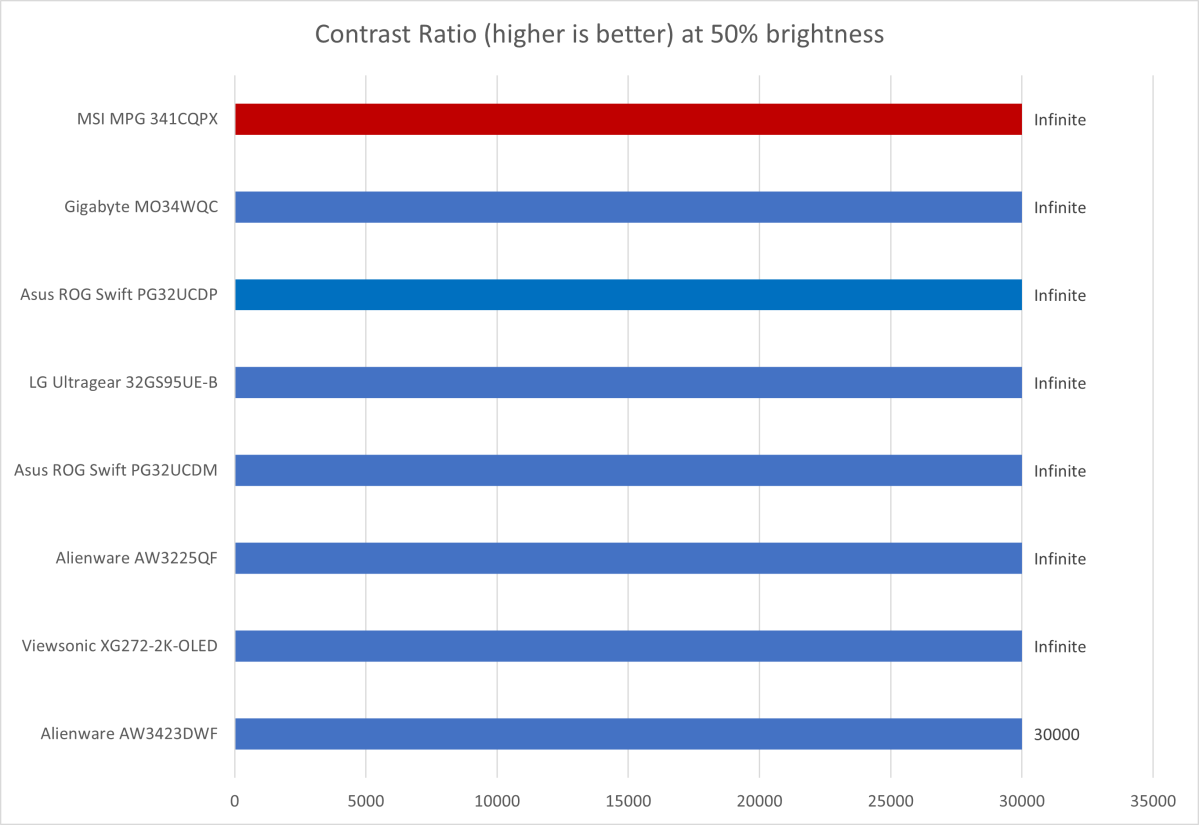
Matthew Smith / Foundry
Matthew Smith / Foundry
Matthew Smith / Foundry
Let’s be real: this is getting to the point where I’m not sure a contrast graph needs to be included in an OLED monitor review. OLED monitors almost always have an effectively infinite contrast ratio, meaning they can achieve a minimum luminance of zero nits. The MPG 341CQPX can deliver an exceptionally deep and immersive image that’s far superior to an LCD monitor — but so can the competition.
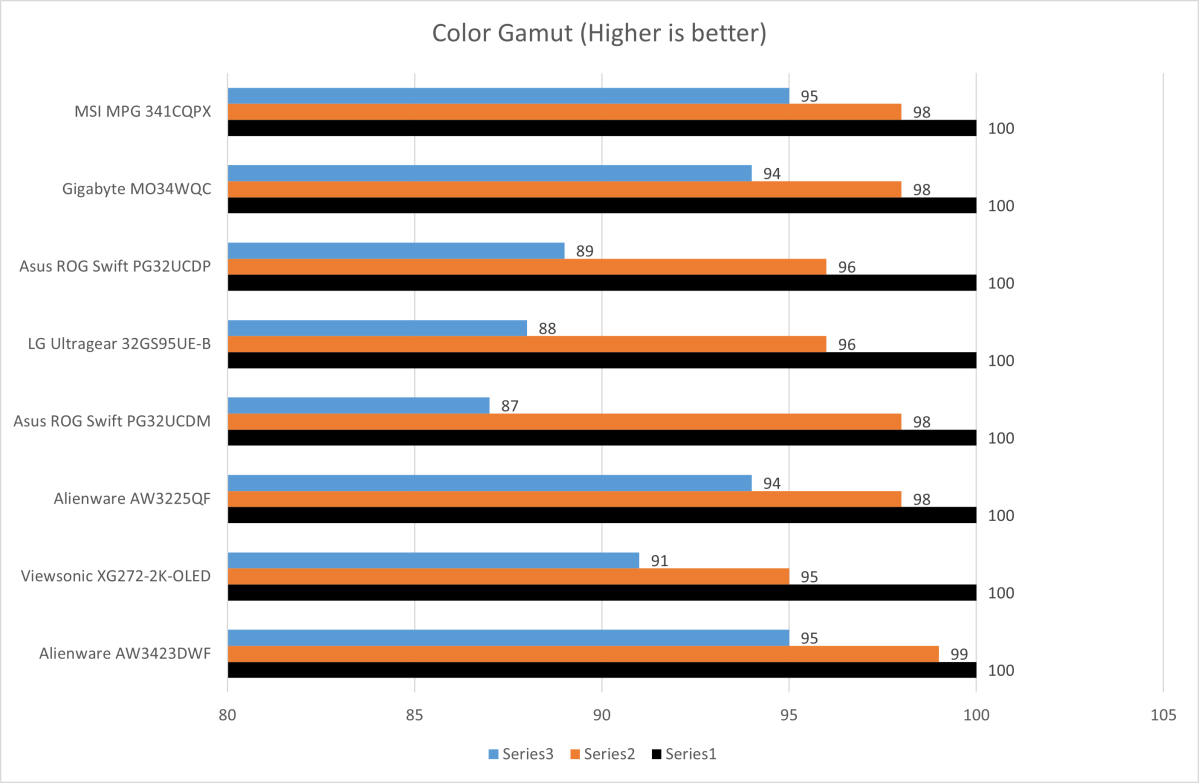
Matthew Smith / Foundry
Matthew Smith / Foundry
Matthew Smith / Foundry
Color gamut, on the other hand, does demonstrate differences between OLED panel technologies.
The MPG 341CQPX has a Samsung QD-OLED panel. The QD stands for “quantum dots,” a technology that improves the color gamut. Thanks to that, the 341CQPX can show a brilliant range of colors that cover 98 percent of DCI-P3 and 95 percent of AdobeRGB. It’s beautiful and vibrant.
That’s also true of other QD-OLED monitors like the Gigabyte MO34WQC and Alienware AW3225QF. However, monitors such as the LG Ultragear 32GS95UE-B instead use an LG WOLED panel, which has a narrower (yet still excellent) color gamut.
Truth be told, this difference doesn’t matter much in PC games or movies, which will look vibrant on both QD-OLED and WOLED monitors. But if you’re a creator who wants the widest gamut possible, QD-OLED monitors like the MPG 341CQPX have the edge.
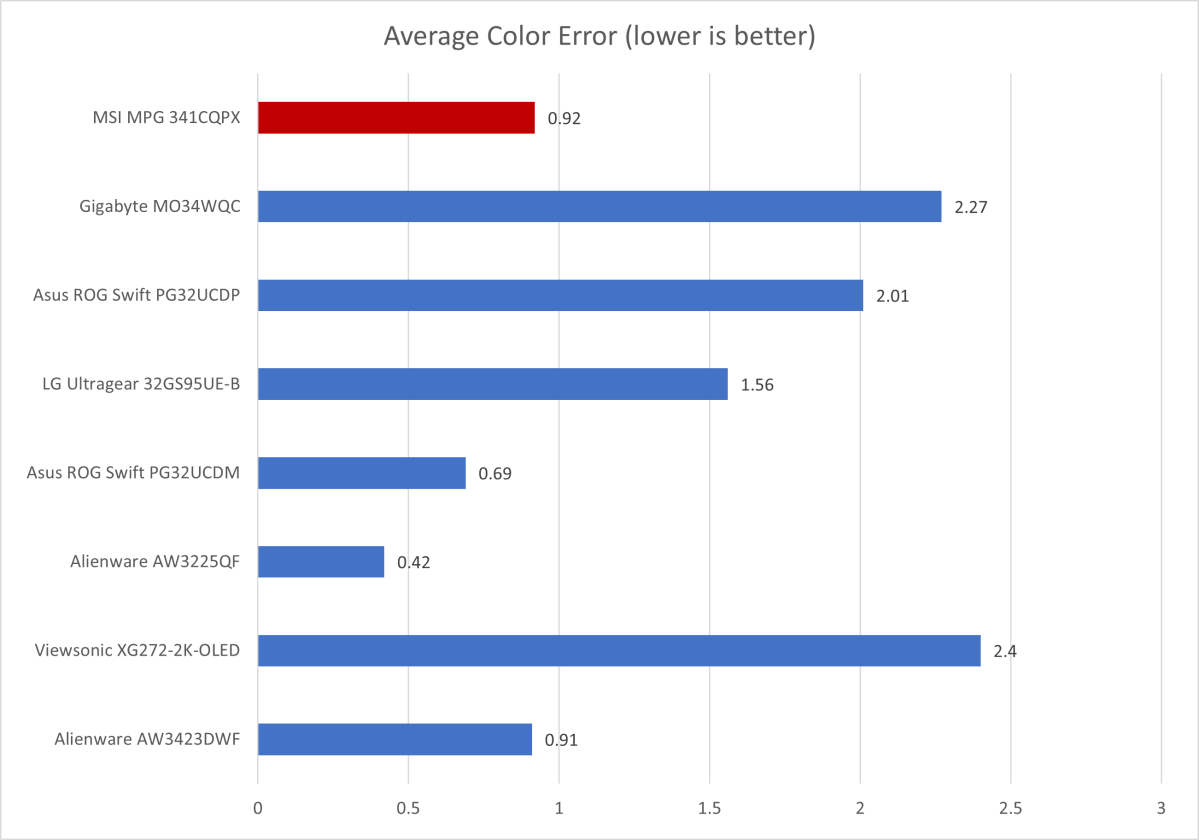
Matthew Smith / Foundry
Matthew Smith / Foundry
Matthew Smith / Foundry
Color accuracy is also a strength for the MPG 341CQPX. Though it doesn’t have the lowest color accuracy we’ve measured, it scores very well, coming in closer to the leader than the losers. This level of color accuracy is more than enough to deliver a realistic picture.
The MPG 341CQPX reached a default color temperature of 6200K, off our target of 6500K, and default gamma of 2.3, off our target of 2.2. In practice, that means the MPG 341CQPX’s image looks a bit darker and warmer than it should. It’s not a big problem — in many situations, it’s not noticeable — but it’s there. This minor downside is shared with many other QD-OLED monitors, which in general tend to be slightly off-target by these metrics.
Sharpness is okay. Like nearly all 34-inch ultrawide monitors, the MPG 341CQPX has a resolution of 3440×1440, which works out to be about 109 pixels per inch. That’s reasonably sharp, though far less so than a 27-inch 4K monitor, which achieves 163 pixels per inch. QD-OLED panels also have issues with pixelation and color artifacting around fine, high-contrast edges, which is due to their unusual subpixel layout. This problem is not often visible in games or movies, but it can be an issue if you work with spreadsheets or documents that have small font sizes. Those who spend a lot of their day staring at text might want to consider a LCD display.
On balance, the MSI MPG 341CQPX’s performance is very similar to other QD-OLED monitors, and broadly similar to OLED monitors as a category. That is good news, as OLED monitors have exceptional contrast and color performance. Brightness remains a bit low in SDR, though, and sharpness might sometimes be inadequate. It’s a fantastic monitor for gaming, movies, and visual content creation, though less impressive for office productivity.
MSI MPG 341CQPX HDR image quality
The MSI MPG 341CQPX, like most QD-OLED monitors, is VESA DisplayHDR True Black 400 certified. That means it can achieve a peak brightness of 400 nits while maintaining a “true black” luminance of zero nits. This is a basic level of VESA DisplayHDR certification, so it doesn’t necessarily guarantee great, or even decent, HDR performance.
However, the MPG 341CQPX also has a 1000 Peak Brightness mode, and ups the ante. In this mode, the monitor can achieve a sustained brightness of 1,012 nits in a 10 percent window, meaning just 10 percent of the display was brightly lit (showing a white HDR image). Increasing the lit area to 50 percent drops brightness to 354 nits, and fullscreen sustained HDR brightness was just 268 nits in this mode.
Those are great results for an OLED monitor, and place the MPG 341CQPX next to some recent LG WOLED monitors, such as the Asus ROG Strix XG27AQDMG. In general, the MSI MPG 341CQPX looks quite bright in HDR with the 1000 Peak Brightness mode turned on. As the numbers show, it’s really at its best when displaying bright highlights. The lightning bolts from Mad Max: Fury Road’s “Into the Storm” scene were brilliant and well-defined, for example.
Subjectively, I felt the improvement of the 1000 Peak Brightness mode was clear. Highlights were not as often blown out and I saw more detail in brighter areas of a scene. After going back and forth, I decided that I prefer the 1000 Peak Brightness mode, and I’m glad to see it was included.
Still, even this mode can struggle to pick up luminance detail in scenes where more of the display must be lit, and scenes that light the entire screen—like an action sequence on a snowy mountain — can look a bit dull. That remains a challenge for OLED monitors, which still falter in fullscreen HDR brightness.
MSI MPG 341CQPX motion performance
The MSI MPG 341CQPX has a refresh rate of 240Hz. While that is not unusual for an OLED monitor, it is unusual for a 34-inch QD-OLED. I’m sure that many other monitors will soon follow suit but, for now, it gives the MSI an edge over older competitors.
Motion clarity is fantastic. That’s thanks not only to the 240Hz refresh rate, which reduces motion blur due to persistence of vision, but also OLED’s quick pixel response times, which reduce ghosting. In general, small fast-moving objects are easy to identify and many details, including small text, remain at least partially readable. It’s not as good as a 360Hz OLED like the Alienware AW2725DF, but it’s still great.
Strangely — or, perhaps not — MSI lists support for Adaptive Sync technology but doesn’t list AMD FreeSync or Nvidia G-Sync Compatible certification. This is not as much of a problem as it might seem because Adaptive Sync, FreeSync, and G-Sync Compatible are broadly compatible with each other, and I confirmed the MSI worked with AMD FreeSync via my AMD Radeon 7800 XT. Frankly, I think we’re going to see FreeSync and G-Sync certifications fade from relevance as VESA Adaptive Sync becomes the industry standard in coming years.
We’re not there yet, though, and I still prefer to see certification, as it gives shoppers peace of mind that the monitor will work correctly with their AMD or Nvidia video card.
Should you buy the MSI MPG 341CQPX?
The MSI MPG 341CQPX is a great entry into the OLED arena with several advantages over most competitors. In addition to all the usual strengths of OLED, like outstanding contrast and color performance, it has a 240Hz refresh, good HDR highlights (in the 1000 Peak Brightness mode), and a USB-C port with useful Power Delivery. MSI would do well to improve the look of its design, and the oversized stand is an annoyance, but the latter problem is easily solved with a monitor arm. The MPG 341CQPX is a great choice if you want a 34-inch ultrawide OLED monitor for games, movies, or content creation.
